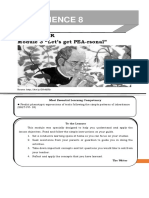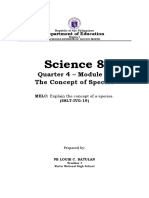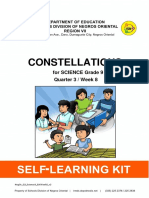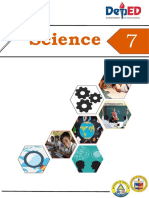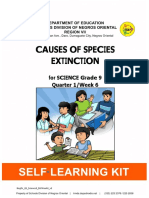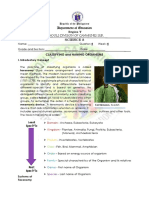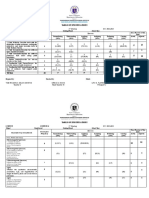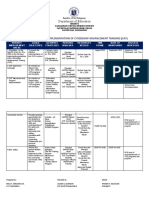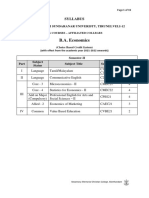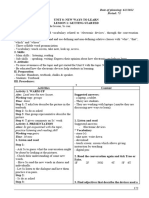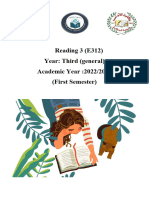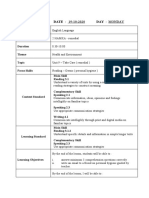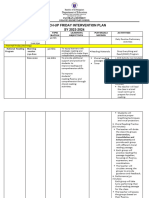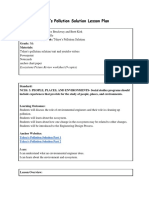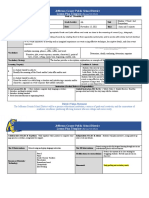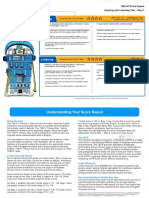7
Quarter 1
Learning Activity Sheet
Lesson
For Science 5
�Learning Activity Sheet for Science Grade 7
Quarter 1: Lesson 5 (Week 5)
S.Y. 2024-2025
This material is intended exclusively for the use of teachers participating in the pilot
implementation of the MATATAG K to 10 Curriculum during the School Year 2024-2025. It
aims to assist in delivering the curriculum content, standards, and lesson competencies. Any
unauthorized reproduction, distribution, modification, or utilization of this material beyond the
designated scope is strictly prohibited and may result in appropriate legal actions and
disciplinary measures.
Borrowed content included in this material are owned by their respective copyright
holders. Every effort has been made to locate and obtain permission to use these materials
from their respective copyright owners. The publisher and development team do not represent
nor claim ownership over them.
Development Team
Writers:
• Dr. Justina T. Lantajo (Leyte Normal University)
Validator:
• Dr. Ma. Victoria D. Naboya (Leyte Normal University)
Management Team
Philippine Normal University
Research Institute for Teacher Quality
SiMERR National Research Centre
Every care has been taken to ensure the accuracy of the information provided in this
material. For inquiries or feedback, please write or call the Office of the Director of the Bureau
of Learning Resources via telephone numbers (02) 8634-1072 and 8631-6922 or by email at
blr.od@deped.gov.ph.
� LEARNING ACTIVITY SHEET 1
Learning Area: Science Quarter: 1
Lesson No.: 5 Date:
Lesson Title/ Topic: Hypothesis and Variables
Name: Grade & Section:
I. Activity No. 1: Hypothesis and Variables (20 Minutes)
II. Objective(s):
At the end of the lesson, the learners shall be able to:
a. identify the different types of variables,
b. make hypotheses based on the given scientific problem.
III. Materials Needed: Reading Material, concept map
IV. Instructions:
For this activity, the students will be grouped into four. Each group will have their assigned
station.
o Experiment Procedure
There will be a situation posted in each station. The students will identify the, independent
and dependent variables. The students will also write the hypotheses of each station on their
science notebook. After three (3) minutes, they will exchange stations.
Reading/Viewing Guide
STATION 1
Manuel is a farmer. He noticed that there are mice that were pests on their rice crops. Their
harvest of rice crops decreases. The supply of rice affected their town. Which resulted, to a
high price of rice. He uses three steps. First, he mixed 20g bait phosphorus material into
the soil; second, he places a scarecrow on the farm and lastly, he planted peppermint in
between the rice crops.
STATION 2
Mary’s mother is a “plantita”. During the pandemic, she planted tomatoes. Because of lack
of space, some tomatoes were planted on the garden soil, while others were on the small
pots. She observed that her plant growth and its fruits differ, although she planted them
simultaneously. Because of lack of space, there were tomatoes planted on the garden, others
were in small pots. The tomatoes planted on the garden receives enough amount of sunlight.
The tomatoes planted on the pots were placed inside on their house. Both were watered and
were given same amount of fertilizers.
Science 7 Quarter 1 1
� STATION 3
During the Brigada eskwela, teacher Mara is cleaning her room. She mops the floor and
cleans the board and chairs. While cleaning, she noticed bubble gum stains on the wall. She
wanted to remove the stain before she repainted the wall. She tried to use oil, water and ice
to remove the bubble gum stain.
STATION 4
Joseph loves to eat. One of his favorite food is a sandwich. He makes it with peanut butter,
jams, ham, and even portions of margarine. His mother bought two packs of
bread. As he was about to prepare his sandwich, he saw molds on the sides of the bread.
He ran to his mom and told her about the molds. His mom told him to put a slice of bread
inside an air- tight container, the other slice to put in a paper bag and the remaining
slices, he left in the bread plastics.
o Complete the table below.
INDEPENDENT DEPENDENT
STATION HYPOTHESIS CONTROLLED
VARIABLE VARIABLE
o Guide Questions
The learners will be asked to read and answer the following questions:
Q1. Based on the situations, what are the formulated hypotheses?
_____________________________________________________________________________________________
_____________________________________________________________________________________________
_____________________________________________________________________________________________
_____________________________________________________________________________________________
Q2. What are the variables in Station 1? How about in Station 2? In Station 3? In Station 4?
_____________________________________________________________________________________________
_____________________________________________________________________________________________
_____________________________________________________________________________________________
_____________________________________________________________________________________________
Science 7 Quarter 1 2
�Problem Sets
Read and answer the following. Choose the letter of the correct answer.
1. Which is the independent variable?
A. the amount of water C. the times of stirring
B. the amount of sugar D. the temperature of water
2. Which is the dependent variable?
A. the dissolving time of sugar C. the number of granules left
B. the heating time of water D. the temperature of water
3. Which are the controlled variables?
I. water temperature III. amount of sugar V. stirring time
II. amount of water IV. dissolving time of sugar
A. I, II, III, IV C. II, III, V
B. II, II, IV D. I, III, IV
4. Mary wants to know at which temperature the salt dissolve faster in water.
What is the dependent variable in the situation?
A. the level of water C. the source of water
B. the type of water D. the temperature of water
5. How can a scientist know if his/her hypothesis is effective or not?
A. rely on wild guess
B. observe from others
C. test hypothesis thru testing
D. conclude based on gathered info from others
o Other related tasks
Answer the question below on your notebook. Complete the sentence below.
Three things I learned ……
_________________________________________________________________________________________
_________________________________________________________________________________________
_________________________________________________________________________________________
_________________________________________________________________________________________
V. Extended Practice:
Give two situations. Formulate hypothesis of the problem and identify the given
variables.
Science 7 Quarter 1 3
� LEARNING ACTIVITY SHEET 2
Learning Area: Science Quarter: 1
Lesson No.: 5 Date:
Lesson Title/ Topic: Experimentation
Name: Grade & Section:
I. Activity No. 2: Experimentation (15 Minutes)
II. Objective(s): At the end of the lesson, the learners shall be able to:
a. conduct an experiment to prove hypothesis; and
b. determine the procedure in a given experiment.
III. Materials Needed: Reading Material, activity or science notebook
IV. Instructions:
o Experiment Procedure
For this activity, the students will be grouped into four. Each group will have their assigned
station. On each station, there will be illustrations, text, and simple simulations to show the
experimentation.
o Reading/Viewing Guide
STATION 1 (Figure A)
Manuel is a farmer. He noticed that there were mice that were pests on their rice crops. Their
harvest of rice crops decreases. The supply of rice affected their town. Which resulted in a
high price of rice. He uses three steps. First, he mixed 20g bait phosphorus material into
the soil; second, he placed a scarecrow on the farm and lastly, he planted peppermint in
between the rice crops.
STATION 2 (Figure B)
Mary’s mother is a “plantita”. During the pandemic, she planted tomatoes. Because of lack
of space, some tomatoes were planted on the garden soil, while others were on the small
pots. She observed that her plant growth and its fruits differ, although she planted them
simultaneously. Because of lack of space, there were tomatoes planted in the garden, others
were in small pots. The tomatoes planted in the garden receive enough sunlight. The
tomatoes planted on the pots were placed inside their house. Both were watered and were
given the same amount of fertilizers.
Science 7 Quarter 1 4
� STATION 3 (Figure C)
During the Brigada Eskwela, teacher Mara is cleaning her room. She mops the floor and
cleans the board and chairs. While cleaning, she noticed bubble gum stains on the wall. She
wanted to remove the stain before she repainted the wall. She tried to use oil, water and ice
to remove the bubble gum stain.
STATION 4 (Figure D)
Joseph loves to eat. One of his favorite foods is a sandwich. He makes it with peanut butter,
jams, ham, and even portions of margarine. His mother bought two packs of bread. As he
was about to prepare his sandwich, he saw molds on the sides of the bread. He ran to his
mom and told her about the molds. His mom told him to put a slice of bread inside an air-
tight container, the other slice to put in a paper bag and the remaining slices he left in the
bread plastics.
o Guide Questions
1. How many experiments were done in each station?
_____________________________________________________________________________________
_____________________________________________________________________________________
2. Can you describe the procedure of the experiment on the first station? How about the
2nd? 3rd? and 4th station?
_____________________________________________________________________________________
_____________________________________________________________________________________
3. Which of the experiments in the first station worked? How did you say so? How about
the 2nd station? 3rd station? 4th station?
_____________________________________________________________________________________
_____________________________________________________________________________________
4. How will you say that the experiment worked well?
_____________________________________________________________________________________
_____________________________________________________________________________________
5. Does the experiment show a fair testing? How did you say so?
_____________________________________________________________________________________
_____________________________________________________________________________________
Science 7 Quarter 1 5
� LEARNING ACTIVITY SHEET 3
Learning Area: Science Quarter: 1
Lesson No.: 5 Date:
Lesson Title/ Topic: Drawing Conclusions
Name: Grade & Section:
I. Activity No. 3: Drawing Conclusions (15 Minutes)
II. Objectives:
At the end of the lesson, the learners shall be able to:
a. Define what is conclusion; and
b. Draw conclusions from a given scientific scenarios.
III. Materials Needed:
Reading Material posted on the wall (stations 1 to 4)
IV. Instructions:
o Experiment Procedure
1. For this activity, the students will be grouped into four. Each group will have their
assigned station. The students will draw their conclusions based on the different
scenarios.
o Reading/Viewing Guide
STATION 1 (Figure A)
Manuel is a farmer. He noticed that there are mice that were pests on their rice crops.
Their harvest of rice crops decreases. The supply of rice affected their town. Which
resulted, to a high price of rice. He uses three steps. First, he mixed 20g bait phosphorus
material into the soil; second, he places a scarecrow on the farm and lastly, he planted
peppermint in between the rice crops.
STATION 2 (Figure B)
Mary’s mother is a “plantita”. During the pandemic, she planted tomatoes. Because of
lack of space, some tomatoes were planted on the garden soil, while others were on the
small pots. She observed that her plant growth and its fruits differ, although she planted
them simultaneously. Because of lack of space, there were tomatoes planted on the
garden, others were in small pots. The tomatoes planted on the garden receives enough
Science 7 Quarter 1 6
� amount of sunlight. The tomatoes planted on the pots were placed inside on their house.
Both were watered and were given same amount of fertilizers.
STATION 3 (Figure C)
During the Brigada eskwela, teacher Mara is cleaning her room. She mops the floor and
cleans the board and chairs. While cleaning, she noticed bubble gum stains on the wall.
She wanted to remove the stain before she repainted the wall. She tried to use oil, water
and ice to remove the bubble gum stain.
STATION 4 STATION 4 (Figure D)
Joseph loves to eat. One of his favorite food is a sandwich. He makes it with peanut
butter, jams, ham, and even portions of margarine. His mother bought two packs of
bread. As he was about to prepare his sandwich, he saw molds on the sides of the bread.
He ran to his mom and told her about the molds. His mom told him to put a slice of
bread inside an air- tight container, the other slice to put in a paper bag and the
remaining slices, he left in the bread plastics.
o Guide Questions
1. What conclusion can you draw from the scenario in Station 1? How about in Station 2?
Station 3? And Station 4?
_____________________________________________________________________________________
_____________________________________________________________________________________
_____________________________________________________________________________________
2. How can you draw conclusions?
_____________________________________________________________________________________
_____________________________________________________________________________________
_____________________________________________________________________________________
3. What is the importance of conclusion in science.
_____________________________________________________________________________________
_____________________________________________________________________________________
_____________________________________________________________________________________
Science 7 Quarter 1 7
� o Problem Sets
Complete the table below by supplying the conclusion based on the given information.
DATA GATHERED/
PROBLEM HYPOTHESIS VARIABLES CONCLUSION
RESULTS
Are there more Hypothesis Dependent 200 cases of
people infected No. 1. Variable: infected people
with Covid 19 More people More or less were under GCQ in
under General were infected people were Area A.
Community with Covid 19 infected 150 cases of
Quarantine or under GCQ infected people
in Modified than MECQ? Independent were under MECQ
Enhanced Variable: in Area A.
Community Hypothesis GCQ and MECQ No reported cases
Quarantine No. 2 for three days
(MECQ)? Less people Constant under GCQ but
were infected Variable: with several cases
with Covid 19 Specific area under MECQ.
under GCQ under GCQ and It was found out
than MECQ? MECQ under that there are more
study cases of infected
people with Covid
19 in Area A with
200 cases under
GCQ.
There were about
50 cases less of
people infected
with Covid 19
under MECQ in
Area A.
o Other related tasks
Answer the question below on your notebook. Complete the sentence below.
Three things I learned ……
Two things I wonder…..
One question I still have….
V. Extended Practice:
The students can give other examples of situations and they will draw conclusions from situations.
Science 7 Quarter 1 8
� LEARNING ACTIVITY SHEET 4
Learning Area: Science Quarter: 1
Lesson No.: 5 Date:
Lesson Title/ Topic: Hypothesis and Variables
Name: Grade & Section:
I. Activity No. 4: Hypothesis and Variables (15 Minutes)
This activity is based from Homework 1.d of Quarter 1, Week 5, Day 4 of the lesson
exemplar.
II. Objective(s): At the end of the lesson, the learners shall be able to:
a. Define application.
b. Apply the scientific method in investigating certain scenario.
III. Materials Needed: 1 whole sheet of paper
IV. Instructions:
o Experiment Procedure
1. Look for a partner.
2. Complete the given table below.
o Reading/Viewing Guide
Science 7 Quarter 1 9
� o Problem Sets
1. What skill does a scientist show when he/she listens to the sounds that whales make?
A. Making a hypothesis C. Interpreting data
B. Making observations D. Drawing conclusion
2. Which question would be the best high-level scientific question?
A. How many giraffes live in Africa?
B. Who made the first microscope?
C. How long ago did dinosaurs live on Earth?
D. Does the amount of salt in water affect the temperature at which it boils?
3. What do you call the series of steps designed to help you solve problems and answer
questions?
A. Experiment C. Observation
B. Hypothesis D. Scientific Method
4. In science, an educated guess is called a/an
A. Conclusion C. Observation
B. Hypothesis D. Question
5. When you decide whether or not the data supports the original hypothesis, you are
A. Asking questions C. Making observations
B. Drawing conclusions D. Forming a hypothesis
6. When a scientist shares her findings with other scientists, she is
A. Experimenting C. Making a hypothesis
B. Analyzing data D. Communicating results
7. The final part or a summary of reasonable inferences is/an
A. Conclusion C. Question
B. Hypothesis D. Controlled experiment
8. Anything that can change in an experiment is called_________.
A. Experimenting C. Hypothesis
B. Conclusion D. Variable
9. All good experiment should be ______________.
A. Explainable C. Testable
B. Questionable D. Thoughtful
10. Which of the following does not belong to the group?
A. Conclusion C. Hypothesis
B. Experiment D. Plagiary
V. Extended Practice:
The students can give other examples of situations which they can apply the scientific
method.
Science 7 Quarter 1 10










